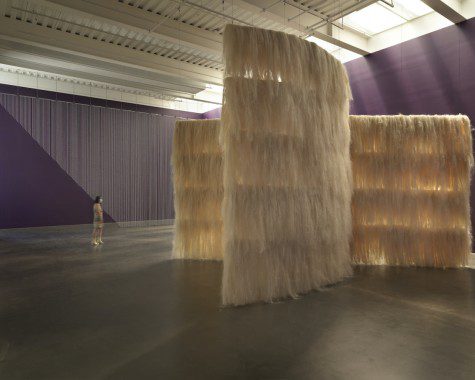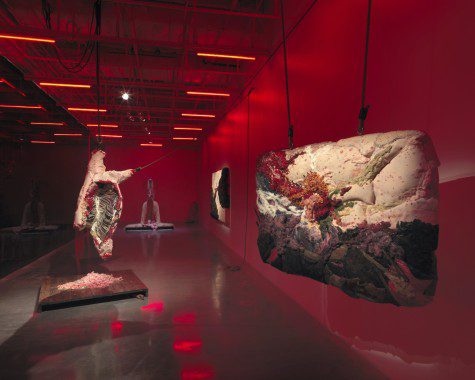Review: Artistic power in Kapwani Kiwanga’s ‘Off-Grid’ and Doreen Lynette Garner’s ‘REVOLTED’
The New Museum exhibits, “Off-Grid” and “REVOLTED,” employ unconventional approaches to exposing the abuse of higher authority.
October 17, 2022
Two of the New Museum’s most recent exhibits, Kapwani Kiwanga’s “Off-Grid” and Doreen Lynette Garner’s “REVOLTED,” are beautifully intriguing, raw representations of the effects of aggressive authority. The artworks were not only created to delight the naked eye. Instead, they depict the resistance of racially discriminatory power which targeted, controlled and abused enslaved people in the United States.
Kiwanga’s “Off-Grid” exhibit was shown on the fourth floor of the museum. The tall ceilings allowed for the three massive art pieces to be displayed in a manner that emphasized their size. A piece that stood out was “Cloak,” a visual illusion made out of strings of metal beads hanging from the ceiling and cut in a diagonal. Created from various forms of aluminum and steel, these metal elements were transformed through a process known as metalizing — a coating process that sprays melted substances onto objects.

According to the New Museum, Kiwanga did this metal-altering process “as a way to understand underlying structures of power at work in the world,” making the viewer question whether this illusion is a visual representation of the manipulation of discriminated minorities by a higher authority.
To depict this illusion of power, the exhibit does not use artificial lighting. This idea was inspired by Kiwanga’s study of the lantern laws in 18th century colonial America. These laws forced enslaved Indigenous and Black people to hold lanterns at night so authorities could keep track of them. To reflect this injustice in her artwork, Kiwanga collected New York City Police Department floodlights that were placed in areas that required more illumination or monitoring. Realizing that the aluminum in the floodlights creates reflection, Kiwanga cut out the aluminum, melted it, placed it in a spray gun that turned the metal into a paint that could absorb light, and metalized the bead curtain.
Although the focus of this exhibit was to depict how light can represent control and monitoring, Kiwanga also wanted to describe how people try to hide from the public eye. Kiwanga found a way to use her art to represent enslaved people living under the intense surveillance of those in control, while simultaneously depicting people’s inclination to be unseen.
Meanwhile, on the first floor, there is a smaller room near the back hidden by a red transparent glass wall, which housed Garner’s “REVOLTED” exhibit. One of the provocative artworks is titled “I’d Rather the Viscera of Me Floating on the Surface of the Sea than Be Dragged into Hell by Those Pale and Free.” The sculpture appeared to be a large blob of fake flesh, organs, blood, glass, wood and coral, adding to its unconventionality.

The entire exhibit refers to the New Britannia slave ship in 1773, where enslaved men managed to confiscate weapons and killed around 300 crewmen, while also blowing up the ship. Similarly, “I’d Rather the Viscera of Me Floating on the Surface of the Sea than Be Dragged into Hell by Those Pale and Free” is inspired by J.M.W. Turner’s “The Slave Ship” painting that depicted the Zong Massacre in 1781. The captain of the ship ordered around 100 sick enslaved men to jump overboard and retrieve allegedly misplaced insurance papers. The effects of this authoritative violence is visibly displayed in Garner’s artwork.
It’s one thing to hear about a devastating moment in history, but it’s an entirely different experience when you are immersed in a representation of the tragic repercussions. This collage of the shards of glass, the bloody organs of victims, the broken wood and the strips of seaweed gives the audience graphic visuals of what happened to the enslaved men in 1781.
Kiwanga indirectly referenced the idea of invisibility and surveillance by altering metal into an opaque material. Garner’s abject and cultivating sculptures directly depicted the violence enslaved Black people experienced and fought against during the slave trade. Both exhibitions prove successful for artists to find a way to regain control of what they lost by deciding what they create and what the audience sees.
Contact Afnan Abbassi at [email protected]























































































































































